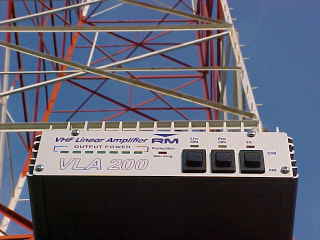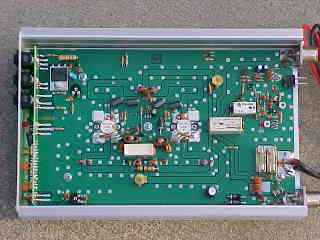| Author |
Message |
    
Forummaster
| | Posted on Tuesday, May 06, 2003 - 12:18 pm: | 


|
VLA 200 Review
by Tech 833
RF amplifiers are an item utilized by two way radio users to amplify the transmitter output power provided by the radio itself to a higher level needed in some instances to complete otherwise intermittent communications. Since an amplifier is typically not a wide-band device, especially as power level increases, many models of RF amplifiers are available.
The company that brings you the line of reliable KLV amplifiers for HF bands has now produced a new line of amplifiers to cover the VHF and UHF amateur (ham) bands. The VLA-200 is designed to operate in the 144-148 MHz. spectrum. According to the included instructions, the VLA-200 has a rated output power of 200 watts (250 peak) with maximum 50 watt input and requires 12 volts DC for operation. The VLA-200 also includes a receiver preamplifier that boosts received signals by as much as 25 dB.
I was given the opportunity to test and use the VLA-200 for an extended period of time and have used it extensively in demanding applications to assess its reliability and observe its operating characteristics.

My first impression of the VLA-200 is of the robust construction and attention to detail. The case is made of an aluminum alloy with a nicely brushed finish. The front panel is perfectly silk screened and drilled for the indicators and switches as the photo shows. This is clearly a high quality product.
I opened the VLA-200 to observe the internal construction and found that similar if not greater detail was spent on the internal components.

The soldering was very solid and circuit board layout very clean and with enough room between components to facilitate simple repairs if the need should arise. As you can also see in the photo, the amplifier transistors are internally fused with 12 Amp auto blade type fuses to help protect them. The circuit board screening is flawless and the varnish coating is nothing less than perfect.
The VLA-200 has built in transmit/receive switching that senses when your transmitter is keyed and then switches the amplifier from receive to transmit mode via an internal relay. In addition, the internal relay can be controlled with an external switch by using the terminals on the back of the amp. Normally, this would come in handy for SSB and CW operations that do not have continuous carrier like AM and FM modes do. However, the VLA-200 has a SSB switch on the front panel, which introduces a delay in the T/R internal relay making SSB operation possible without having to use the external option.
Operating the VLA-200 is as simple as connecting the power, antenna, and two-way radio. The rear panel RF connections are UHF type for radio and antenna while the power is connected via short red/black jumper. Front panel controls are amp on/off, preamp on/off, and FM/SSB mode. The front panel indications are a 7-segment power output meter and tally lights for each switch selection.
IN THE FIELD: In FM mode on 146 MHz., I put the VLA-200 through its paces. The receiver preamplifier is very quiet with a noise floor considerably below –90. Since there is very little noise on the VHF band anyway, the preamplifier is something I have come to appreciate. However, when driving through downtown, it did substantially increase the level of intermodulation I received from nearby high power paging and two-way transmitters.
Since the entire upper surface and sides of the VLA-200 case is heat sink, it takes a long time to heat up the VLA-200 when transmitting. I put the VLA-200 through the ultimate grueling test of any transmitter- continuous keying and varying loads. Running 4.5 watts input and about 30 watts output, the VLA-200 is capable of continuous duty operation. As the VLA-200 heats up to potentially damaging levels, the output power level slowly drops which helps protect the output transistors from heat damage. This also illuminates the ‘Protection Warning’ indicator on the front panel. If you run higher power levels, the VLA-200 will not be able to continuously transmit without going into thermal shutdown. However, for the typical 5-5-10 duty cycle, the VLA-200 running 150 watts will run very warm but not dangerously hot.
ON THE BENCH: Back at the shop, I connected the VLA-200 to the service monitor to give it the technician once-over. The VLA-200 output is especially clean with spurs and harmonics remaining at relative levels whether the amp was on or not. In other words, the VLA-200 will not increase baseband spectrum noise above what your radio already puts out. The VLA-200 is very, very clean!
The output power is slightly over-rated as the two transistors used in the VLA-200 (NTE equivalent is the 352) are actually rated for a maximum input of 18 watts and an output of 80 watts each (safe maximum). That would mean that the VLA-200 will take 36 watts input and give 160 watts output safely. Beyond that, you risk great damage to the transistor devices! I was able to run 150 watts for short periods of time with 35 watts input for testing. The VLA-200 did not strain under load until SWR reached levels of 1.5:1 or greater. Although the VLA-200 will operate into higher loads, the temperature increases at exponential rates as the load rises above 1.5:1. For you ‘techies’, you should know that the VLA-200 is much more forgiving of inductive loads, but does not tolerate capacitive loads for very long.
Running just 30 watts output, the VLA-200 draws nearly 12 amps from the bench supply at 13.6 volts. Naturally, a great deal of the power not converted into RF becomes heat, and the VLA-200 creates a lot of heat. If you were to run the VLA-200 at higher levels for extended periods of time, the addition of extra heat sink is suggested.
For an everyday mobile or base amplifier, the VLA-200 is an exceptionally well built workhorse of an amplifier that will last a long time. Most users will probably never run the VLA-200 as hard as I have for these tests, but it’s nice to know that if you ever do, it will stand up to it and gladly ask for more.
Tech 833 |
|



